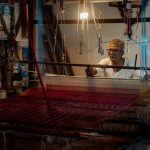You’ll find aramid felt fabric excels with its heat resistance up to 500°C, outstanding mechanical strength, and inherent flame-retardant properties, making it ideal for demanding environments. It also offers excellent electrical insulation and chemical resistance. Industries like aerospace, automotive, and protective gear lean on it for durability, safety, and performance. Its unique combination of features keeps you protected and efficient. Explore how this versatile material fits your specific industrial needs and applications.
Table of Contents
Key Takeaways
- Aramid felt fabric offers exceptional tensile strength, abrasion resistance, and durability due to its aromatic polyamide polymer structure.
- It withstands extreme temperatures up to 500°C, providing excellent heat resistance and fire retardant properties without melting or igniting.
- The fabric’s dense structure traps air, reducing thermal conductivity and making it an effective insulation material.
- It exhibits high dielectric strength and moisture resistance, ensuring reliable electrical insulation in harsh and humid environments.
- Common industrial uses include automotive heat shields, aerospace thermal barriers, and protective clothing for firefighters and military personnel.
Chemical Composition and Structure of Aramid Felt
Aramid felt owes its strength and heat resistance to its unique chemical composition and molecular structure. You’ll find that aramid fibers are made from aromatic polyamides, which consist of benzene rings linked by amide bonds.
Aramid felt’s strength and heat resistance come from aromatic polyamides with benzene rings linked by amide bonds.
This arrangement creates a rigid, highly stable polymer chain that resists stretching and degradation. When these fibers are processed into felt, they form a dense, interlocked network that enhances durability without sacrificing flexibility.
The molecular structure encourages strong hydrogen bonding between chains, giving the felt exceptional tensile strength and chemical resistance. Because you’re dealing with a synthetic fiber that’s inherently flame-resistant, the chemical design itself prevents combustion.
Understanding this foundation helps you appreciate why aramid felt performs so well in demanding environments.
Thermal Resistance and Heat Insulation Capabilities
You’ll find that aramid felt fabric handles extreme temperatures without breaking down, making it ideal for high-heat environments.
Its excellent insulation efficiency helps keep heat contained or blocked, improving safety and energy savings.
Let’s explore how these thermal properties benefit your applications.
High Temperature Endurance
When you need materials that withstand extreme heat without degrading, this fabric stands out for its exceptional thermal resistance.
Aramid felt fabric endures temperatures up to 500°C (932°F) and sometimes even higher, depending on its specific composition. You can rely on it to maintain structural integrity and performance in harsh environments like furnaces, automotive engines, and aerospace components.
Unlike many materials that weaken or melt under intense heat, this fabric retains strength and flexibility, ensuring safety and durability. Its inherent flame resistance means you don’t have to worry about ignition or rapid deterioration.
When your applications demand consistent performance under thermal stress, aramid felt fabric offers a reliable solution, protecting equipment and personnel from heat exposure while lasting far longer than conventional fabrics.
Insulation Efficiency Benefits
Beyond just resisting high temperatures, this fabric excels at minimizing heat transfer, making it highly effective for insulation purposes. Its dense yet flexible structure traps air, reducing thermal conductivity and keeping environments stable. You’ll find it invaluable in applications where maintaining temperature control and energy efficiency matters.
| Benefit | Description | Application Example |
|---|---|---|
| Thermal Resistance | Limits heat flow through material | Heat shields in engines |
| Lightweight Insulation | Adds minimal bulk while insulating | Aerospace panels |
| Chemical Stability | Maintains insulation under exposure | Industrial furnace lining |
| Durability | Resists degradation over time | Protective clothing layers |
Using this fabric helps you save energy and enhances safety in demanding environments.
Mechanical Strength and Durability Features
You’ll appreciate how aramid felt fabric stands out with its impressive tensile strength, making it tough under pressure.
It also resists wear and tear exceptionally well, so it lasts longer in demanding conditions.
Let’s explore how these features boost its mechanical durability.
Tensile Strength Benefits
Because aramid felt fabric boasts exceptional tensile strength, it offers outstanding mechanical durability that stands up to heavy use and stress.
When you work with this fabric, you benefit from its ability to resist breaking under tension, making it ideal for demanding industrial applications. You’ll find it reliable in environments where strength matters, such as in protective gear, insulation, and structural reinforcements.
This tensile strength means the fabric maintains integrity even when stretched or pulled, reducing the risk of failure. By choosing aramid felt, you guarantee your products perform consistently and last longer under challenging conditions.
Its strength supports safety and efficiency, so you can trust it to handle tough jobs without compromising performance.
Wear and Tear Resistance
Aramid felt fabric’s impressive tensile strength naturally contributes to its resistance against wear and tear, making it a reliable choice for long-lasting applications.
When you use it, you benefit from its ability to withstand mechanical stress without compromising integrity. This durability means less frequent replacements and lower maintenance costs.
You’ll find that aramid felt excels in environments where friction, abrasion, and impact are common. Here’s why it stands out:
- High abrasion resistance keeps the fabric intact even under constant rubbing.
- Excellent impact resistance protects against sudden mechanical shocks.
- Superior fatigue resistance guarantees the fabric endures repeated stress cycles.
Fire Retardant Properties and Safety Benefits
When you handle fabrics that resist high temperatures, safety becomes a top priority.
Aramid felt fabric is inherently fire retardant, meaning it won’t easily ignite or melt when exposed to flames. This property gives you peace of mind in hazardous environments, reducing fire risks and potential injuries.
Its ability to self-extinguish helps prevent flames from spreading, protecting both you and the equipment.
Besides fire resistance, aramid felt also offers excellent thermal stability, maintaining integrity even under intense heat.
Using this fabric in protective gear, insulation, or fire barriers enhances overall safety without sacrificing comfort.
Electrical Insulation Characteristics
Though you might prioritize heat resistance, electrical insulation is another essential advantage of aramid felt fabric. When you use it, you benefit from reliable dielectric properties that keep electrical currents safely contained. This makes aramid felt ideal for insulating components in demanding environments.
Here’s why you’ll appreciate its electrical insulation characteristics:
- High dielectric strength: Resists electrical breakdown even under high voltage.
- Low electrical conductivity: Minimizes energy loss and prevents short circuits.
- Moisture resistance: Maintains insulation performance in humid or damp conditions.
Common Manufacturing Processes for Aramid Felt
When you explore aramid felt, you’ll find two main manufacturing methods: needle punching and wet felting.
Each process shapes the fibers differently to create unique fabric properties.
Understanding these techniques helps you choose the right felt for your needs.
Needle Punching Technique
Several key steps define the needle punching technique, a popular method for producing aramid felt fabric.
You start by laying down loose aramid fibers into a web. Then, you repeatedly punch barbed needles through this web, entangling the fibers mechanically. This process strengthens the fabric without using adhesives or heat.
Here’s what makes needle punching stand out:
- Creates durable, dense felt with controlled thickness
- Allows customization of fabric properties by adjusting needle density and depth
- Produces a uniform material ideal for industrial applications
Wet Felting Process
Because you want a dense and uniform aramid felt, the wet felting process offers an effective alternative to needle punching.
In this method, you start by layering aramid fibers and applying moisture, heat, and pressure. The combination causes the fibers to mat and bond tightly without mechanical needling.
You’ll find that wet felting produces a felt with excellent structural integrity and smooth surface, ideal for applications requiring consistent thickness and strength.
Plus, this process reduces fiber damage, preserving the inherent heat resistance and durability of aramid.
Keep in mind, wet felting can be more time-consuming and requires precise control of temperature and moisture levels to achieve ideal results.
Use of Aramid Felt in Automotive Industry
Although you mightn’t see it directly, aramid felt plays an essential role in the automotive industry by enhancing safety and performance.
You’ll find it integrated in areas where heat resistance, strength, and durability matter most. When you choose vehicles with aramid felt components, you’re benefiting from advanced materials designed to protect and improve functionality.
Here’s how aramid felt contributes:
- Acts as a heat shield in engine compartments, preventing damage from high temperatures
- Provides sound insulation, reducing cabin noise for a quieter ride
- Reinforces brake pads and clutch linings, boosting durability and safety
Applications in Aerospace and Aviation
Aramid felt plays a critical role in aerospace and aviation by offering lightweight, heat-resistant, and durable materials that meet the industry’s strict safety standards.
When you use aramid felt, you benefit from its exceptional resistance to high temperatures and flames, making it ideal for insulating aircraft engines and exhaust systems. It also dampens vibrations and reduces noise, enhancing passenger comfort and protecting sensitive equipment.
You’ll find it in seals, gaskets, and thermal barriers, where its strength and stability maintain performance under extreme conditions. Plus, its lightweight nature helps you improve fuel efficiency without compromising safety.
Role in Protective Clothing and Personal Safety Gear
When you need protective clothing that can withstand extreme conditions, felt made from aramid fibers delivers unmatched heat resistance and durability.
You’ll find aramid felt in gear designed to protect firefighters, industrial workers, and military personnel. This fabric resists flames, cuts, and abrasions, keeping you safe in hazardous environments. Its lightweight nature doesn’t compromise comfort, allowing you to move freely while staying protected.
Here’s why aramid felt is ideal for personal safety gear:
- Exceptional thermal stability resists high heat and flames
- Superior strength minimizes cuts and punctures
- Lightweight and flexible for ease of movement
Aramid Felt in Filtration and Environmental Control
Because you need reliable filtration in demanding environments, felt made from aramid fibers offers outstanding performance in capturing fine particles and resisting chemical exposure.
When you use aramid felt in filtration systems, it effectively traps dust, fumes, and other contaminants without degrading under high temperatures or harsh chemicals. This durability guarantees your filters last longer and maintain efficiency, reducing downtime and replacement costs.
In environmental control, aramid felt helps you manage air quality by filtering pollutants in industrial exhausts and ventilation systems. You’ll also appreciate its resistance to moisture and abrasion, which keeps filtration consistent even in challenging conditions.
Maintenance and Longevity of Aramid Felt Products
To keep your felt products performing at their best, regular maintenance is essential. You’ll want to inspect your aramid felt regularly for signs of wear, tears, or contamination that could compromise its effectiveness.
Cleaning is key, but you should avoid harsh chemicals that might degrade the fibers. Instead, use gentle methods appropriate for aramid materials.
Here are three maintenance tips to extend your felt’s lifespan:
- Store in a cool, dry place away from direct sunlight to prevent fiber deterioration.
- Remove dust and debris with a soft brush or low-pressure air to maintain filtration efficiency.
- Avoid exposing the felt to excessive moisture or chemicals that could weaken its structure.
Frequently Asked Questions
What Are the Environmental Impacts of Producing Aramid Felt Fabric?
You should know producing aramid felt fabric consumes significant energy and involves chemicals that may pollute air and water. You’ll want to contemplate its non-biodegradable nature, which can impact landfill waste and environmental health.
How Does Aramid Felt Compare in Cost to Other Industrial Fabrics?
You’ll notice aramid felt typically costs 20-30% more than standard industrial fabrics. But don’t worry, its durability and heat resistance often save you money long-term by reducing replacements and downtime.
Can Aramid Felt Be Recycled or Repurposed After Use?
You can’t easily recycle aramid felt due to its strong fibers, but you can repurpose it for insulation or protective padding. Its durability lets you extend its life instead of just throwing it away after use.
What Are Common Challenges in Working With Aramid Felt During Manufacturing?
Working with aramid felt can feel like wrestling a stubborn octopus—its dust irritates your skin and lungs, cutting and shaping require sharp tools, and its static cling makes handling tricky, demanding careful safety and precision.
Are There Any Known Allergies or Health Risks Associated With Aramid Felt?
You might experience skin irritation or respiratory issues if you handle aramid felt without proper protection. It’s best to wear gloves and masks since dust or fibers can cause allergic reactions or breathing discomfort during manufacturing.
- The Use of Nonwovens in Construction and Civil Engineering - July 11, 2025
- The Use of Nonwovens in Construction and Civil Engineering - July 11, 2025
- The Use of Nonwovens in Construction and Civil Engineering - July 11, 2025







